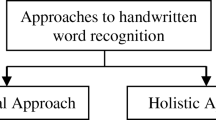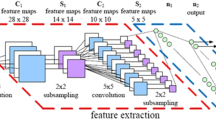Abstract
Holistic-based or segmentation-free handwritten word recognition is one of a pattern recognition problem that aims to recognize the entire word image as a single entity. It is a new modality that recognizes handwritten words from its overall shape and performs better than its complement, i.e., analytic approach for given small lexicon size. Due to technological advancements, society is becoming paperless and prefers to use digital platform for various tasks. This paper deals with the use of holistic approach for the recognition of offline handwritten Devanagari words based on some statistical features. Feature vector sets have been generated to describe each word in the feature space by extracting unıform zoning-, diagonal- and centroid-based features from the database of handwritten word images (50-word classes). Various classifiers, namely K-nearest neighbor (KNN), decision tree and random forest, are employed for the recognition purpose. Furthermore to enhance the system performance, combination of above mentioned features along with gradient boosted decision tree algorithm is proposed. In this way, proposed system achieved maximum recognition accuracy of 94.53% and the attained competent results are comparable with exiting state-of-the-art methods. Moreover, the proposed system has achieved F1-score of 94.56%, FAR of 0.11%, FRR of 5.46%, MCC of 0.945 and AUC of 97.21%.
















Similar content being viewed by others
Explore related subjects
Discover the latest articles and news from researchers in related subjects, suggested using machine learning.Data availability
The datasets generated during and analyzed during the current study are available from the corresponding author on reasonable request.
References
Bhunia AK, Roy PP, Mohta A, Pal U (2018) Cross-language framework for word recognition and spotting of Indic scripts. Pattern Recogn 79:12–31
Budiman E, Kridalaksana AH, Wati M (2017) Performance of decision tree C4.5 algorithm in student academic evaluation. In: Alfred R, Iida H, Ag Ibrahim A, Lim Y (eds) Computational science and technology (ICCST). Lecture Notes in Electrical Engineering, vol 488, pp 380–389
Deore SP (2022) HDWR_SmartNet: a smart handwritten Devanagari word recognition system using deep ResNet-based on scan profile method. Data Sci, pp 57–77
Dutta K, Krishnan P, Mathew M, Jawahar C (2017) Towards accurate handwritten word recognition for Hindi and Bangla. In: Rameshan R, Arora C, Dutta Roy S (eds) Computer Vision, Pattern Recognition, Image Processing, and Graphics. NCVPRIPG 2017. Communications in computer and information science, vol 841, pp 470–480
Ghosh M, Malakar S, Bhowmik S, Sarkar R, Nasipuri M (2019) Feature selection for handwritten word recognition using memetic algorithm. In: Mandal J, Dutta P, Mukhopadhyay S (eds) Advances in intelligent computing. studies in computational intelligence, vol 687, pp 103–124
Gupta JD, Samanta S, Chanda B (2018) Ensemble classifier-based off-line handwritten word recognition system in holistic approach. IET Image Proc 12(8):1467–1474
Gurav Y, Bhagat P, Jadhav R, Sinha S (2020) Devanagari handwritten character recognition using convolutional neural networks. In: IEEE International conference on electrical, communication, and computer engineering (ICECCE), pp 1–6
Jayadevan R, Kolhe SR, Patil PM, Pal U (2011) Offline recognition of Devanagari script: a survey. IEEE Trans Syst Man Cybern Part C (Appl Rev) 41(6):782–796
Jurman G, Riccadonna S, Furlanello C (2012) A comparison of MCC and CEN error measures in multi-class prediction. PLoS ONE 7(8):1–8
Kaur H, Kumar M (2018) A comprehensive survey on word recognition for non-Indic and Indic scripts. Pattern Anal Appl 21(4):897–929
Kaur H, Kumar M (2021) Offline handwritten Gurumukhi word recognition using eXtreme gradient boosting methodology. Soft Comput 25(6):4451–4464
Kaur H, Kumar M (2021) On the recognition of offline handwritten word using holistic approach and AdaBoost methodology. Multimed Tools Appl 80(7):11155–11175
Kaur RP, Kumar M, Jindal MK (2020) Newspaper text recognition of Gurumukhi script using random forest classifier. Multimed Tools Appl 79(11):7435–7448
Kumar S (2016) A study for handwritten Devanagari word recognition. In: IEEE International conference on communication and signal processing (ICCSP), pp 1009–1014
Lee TC, Kashyap RL, Chu CN (1994) Building skeleton models via 3-D medial surface axis thinning algorithms. CVGIP Graph Models Image Process 56(6):462–478
Magotra S, Kaushik B, Kaul A (2020) A comparative analysis for identification and classification of text segmentation challenges in Takri Script. Sadhana. https://doi.org/10.1007/s12046-020-01384-4
Malakar S, Ghosh M, Bhowmik S, Sarkar R, Nasipuri M (2020) A GA based hierarchical feature selection approach for handwritten word recognition. Neural Comput Appl 32(7):2533–2552
Malakar S, Paul S, Kundu S, Bhowmik S, Sarkar R, Nasipuri M (2020) Handwritten word recognition using lottery ticket hypothesis based pruned CNN model: a new benchmark on CMATERdb212. Neural Comput Appl 32(18):15209–15220
Malakar S, Sahoo S, Chakraborty A, Sarkar R, Nasipuri M (2022) Handwritten Arabic and Roman word recognition using holistic approach. Vis Comput. https://doi.org/10.1007/s00371-022-02500-7
Malakar S, Sharma P, Singh PK, Das M, Sarkar R, Nasipuri M (2017) A holistic approach for handwritten hindi word recognition. Int J Comput Vis Image Process (IJCVIP) 7(1):59–78
Narang SR, Kumar M, Jindal MK (2021) DeepNetDevanagari: a deep learning model for Devanagari ancient character recognition. Multimed Tools Appl 80:20671–20686. https://doi.org/10.1007/s11042-021-10775-6
Neelakandan S, Paulraj D (2020) A gradient boosted decision tree-based sentiment classification of twitter data. Int J Wavelets Multiresol Inf Process 18(4):205027
Otsu N (1979) A threshold selection method from gray-level histograms. IEEE Trans Syst Man Cybern 9(1):62–66. https://doi.org/10.1109/TSMC.1979.4310076
Pande SD, Jadhav PP, Joshi R, Sawant AD, Muddebihalkar V, Rathod S, Gurav MN, Das S (2022) Digitization of handwritten Devanagari text using CNN transfer learning–A better customer service support. Neurosci Inform 2(3):100016
Parui SK, Shaw B (2007) Offline handwritten devanagari word recognition: an HMM based approach. In: Ghose A, De, RK, Pal SK (eds) PReMI 2007, LNCS, vol 4815, pp 528–535
Pradeep J, Srinivasan E, Himavathi S (2010) Diagonal feature extraction based handwritten character system using neural network. Int J Comput Appl 8(9):17–22
Ramachandrula S, Jain S, Ravishankar H (2012) Offline handwritten word recognition in Hindi. In: Workshop on document analysis and recognition, pp 49–54, ACM, New York
Roy RK, Mukherjee H, Roy K, Pal U (2022) CNN based recognition of handwritten multilingual city names. Multimedia Tools Appl 81(8):1–17
Sampath A, Gomathi DN (2017) Decision tree and deep learning based probabilistic model for character recognition. J Central South Univ 24(12):2862–2876
Shaw B, Parui SK (2010) A two stage recognition scheme for offline handwritten Devanagari words. In: Machine interpretation of patterns: image analysis and data mining, pp. 145–165, World Scientific
Shaw B, Bhattacharya U, Parui SK (2014) Combination of features for efficient recognition of offline handwritten Devanagari words. In: IEEE International conference on frontiers in handwriting recognition, pp 240–245
Shaw B, Bhattacharya U, Parui SK (2015) Offline handwritten Devanagari word recognition: information fusion at feature and classifier levels. In: IEEE 3rd IAPR Asian conference on pattern recognition, pp 720–724, IEEE Press, Malaysia
Shaw B, Parui SK, Shridhar M (2008) A segmentation based approach to offline handwritten Devanagari word recognition. In: IEEE International conference on information technology, pp. 256–257
Shaw B, Parui SK, Shridhar M (2008) Offline handwritten Devanagari word recognition: A holistic approach based on directional chain code feature and HMM. In: IEEE International Conference on Information Technology, pp 203–208
Singh B, Mittal A, Ansari M, Ghosh D (2011) Handwritten Devanagari word recognition: a curvelet transform based approach. Int J Comput Sci Eng 3(4):1658–1665
Singh S, Garg NK (2019) Optical character recognition techniques for postal automation—a review. In: IEEE International conference on intelligent computing and control systems (ICICCS), pp 1385–1389
Singh S, Garg NK (2022) Performance analysis of thinning algorithms for offline-handwritten Devanagari words. In: Sengodan T, Murugappan M, Misra S (eds) Advances in electrical and computer technologies. ICAECT 2021. Lecture Notes in Electrical Engineering, vol. 881 https://doi.org/10.1007/978-981-19-1111-8_34
Singh S, Garg NK, Kumar M (2022) Feature extraction and classification techniques for handwritten Devanagari text recognition: a survey. Multimed Tools Appl. https://doi.org/10.1007/s11042-022-13318-9
Sokolova M, Lapalme G (2009) A systematic analysis of performance measures for classification tasks. Inf Process Manage 45(4):427–437
Tan S (2006) An effective refinement strategy for KNN text classifier. Expert Syst Appl 30(2):290–298
Wahid MF, Shahriar MF, Sobuj MSI (2021) A classical approach to handcrafted feature extraction techniques for Bangla handwritten digit recognition. In: IEEE International conference on electronics, communications and information technology (ICECIT), pp. 1–4
Author information
Authors and Affiliations
Contributions
Sukhjinder Singh contributed to the database collection, methodology and original draft. Naresh Kumar Garg assisted in the supervision, quality check, review and editing. Munish Kumar Jindal performed the co-supervision, further review and final editing.
Corresponding author
Ethics declarations
Conflict of interest
The authors declare that they have no conflict of interest in this work.
Additional information
Publisher's Note
Springer Nature remains neutral with regard to jurisdictional claims in published maps and institutional affiliations.
Rights and permissions
Springer Nature or its licensor (e.g. a society or other partner) holds exclusive rights to this article under a publishing agreement with the author(s) or other rightsholder(s); author self-archiving of the accepted manuscript version of this article is solely governed by the terms of such publishing agreement and applicable law.
About this article
Cite this article
Singh, S., Garg, N.K. & Kumar, M. On the performance analysis of various features and classifiers for handwritten devanagari word recognition. Neural Comput & Applic 35, 7509–7527 (2023). https://doi.org/10.1007/s00521-022-08045-z
Received:
Accepted:
Published:
Issue Date:
DOI: https://doi.org/10.1007/s00521-022-08045-z




